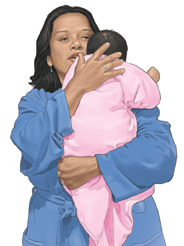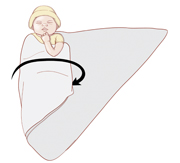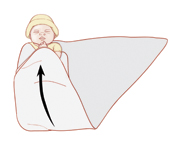Discharge Instructions: When Your Baby Cries
The way your baby cries can tell you how the baby is feeling. It can also alert you to the baby’s needs. This sheet will help you understand what it means when your baby cries, and what you can do to help.
 |
| First try holding the baby to see if the crying stops. If it doesn’t, walking together may help soothe her. |
Crying
It’s normal for babies to cry. Sometimes the baby just wants to be held. But if the crying doesn’t stop, look for a cause. Common causes of crying include:
-
Hunger
-
Discomfort (such as a wet diaper, clothes that are too tight, feeling too hot or too cold, or gas pains)
-
A stuffy nose, which can make it hard for the baby to breathe
-
Stress or overstimulation (especially common in preemies)
-
Illness
What to Do When Your Baby Cries
Crying can be the baby’s way of telling you there’s a problem. The baby trusts you to respond to crying and fix whatever is causing the problem. Figuring out what’s wrong may take some guesswork from you. If holding the baby doesn’t help, here are some other things you can try:
-
Try feeding, in case the baby is hungry. To help prevent gas pains, burp the baby about every 5 minutes while feeding. Also keep the baby’s head higher than the rest of the body while feeding.
-
Check the baby’s diaper. Change it if needed.
-
Give the baby a warm bath.
-
Rock or walk with the baby. Motion is soothing.
-
Wrap the baby snugly in a blanket. This is called swaddling. It makes the baby feel safe and secure. (See the box later on this sheet to learn how to swaddle your baby.)
-
Hold the baby against your bare chest. Skin-to-skin contact can be comforting to the baby.
-
If the baby has a stuffy nose, use a bulb syringe to clear it. (Your baby’s doctor or nurse can show you how to do this.)
-
Check for signs of illness, such as fever or diarrhea. If the baby seems sick, call the doctor.
How to Swaddle Your Baby
Wrapping your baby securely in a blanket (swaddling) helps the baby feel warm and safe. Here is one method:
-
Fold a square blanket diagonally to make a triangle. Turn the triangle so the flat base is at the top and the point is at the bottom.
-
Lay the baby on top of the blanket with his head over the straight base of the triangle and his feet over the point.
-
Pull one side of the triangle all the way over the baby’s torso and tuck it under the baby’s body (Figure 1). A baby is most comfortable with his arms folded over his chest. You can pull the blanket over the baby’s arms to keep them contained. Or, you can leave one arm free so the baby can suck on his fingers. (Try not to wrap the baby with his arms straight down by his sides.)
-
Bring the bottom of the blanket snugly over the baby’s feet and all the way up to his neck (Figure 2).
-
Wrap the other side of the triangle across the baby’s chest (Figure 3).
-
After your baby is swaddled, check often for the following:
-
The blanket stays secure. A loose blanket can cover the baby’s face and cause suffocation.
-
The baby is not overheated. If your baby is hot, remove the blanket and use a light blanket or sheet, and use a lighter blanket or sheet, and swaddle again.
|

|

|

|
|
Figure 1
|
Figure 2
|
Figure 3
|
© 2000-2024 The StayWell Company, LLC. All rights reserved. This information is not intended as a substitute for professional medical care. Always follow your healthcare professional's instructions.